They are some of the most beloved memories of university – the sometimes weird, often wonderful traditions that only happen at U of T: camping in the Mississauga fields, UTSC’s Rez Cup, racing a “chariot” around King’s College Circle. Read on for some of the most popular – and offbeat – U of T pastimes, but don’t expect a complete list. We’re counting on you to tell us about ones we missed!
Unforgettable Dance
“Fireball is amazing,” says Matthew Mohan, a fourth-year criminology student and the person responsible for co-ordinating this year’s formal dance at University College. “I’ve never heard of something similar at any other university.”
More than a thousand students dance into the wee hours each year in six rooms across UC. There’s dinner, dessert, a DJ, ballroom dancing, live bands and sketch comedy by the UC Follies troupe. And there’s always a theme. “Midnight Circus, Alice in Wonderland, Olympian Nights,” says Mohan. “And this year it was the Magic of Fiction.” Each room’s decor evoked classic literature, from Charlie and the Chocolate Factory to the Harry Potter series.
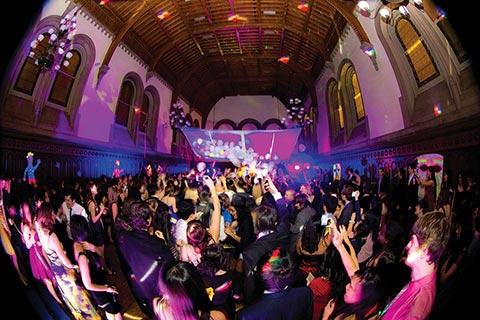
The popular romantic event is always held around Valentine’s Day – for a surprising historical reason that also explains the dance’s name. On February 14, 1890, as UC prepared to host the annual “Conversazione” – featuring music, artifact displays and scientific demonstrations – a tray of flaming kerosene lamps was accidentally dropped down the wooden stairs. Everyone got out unharmed, but half the building was completely gutted. And almost a century later, students, ever irreverent, renamed their dance the UC Fireball.
Watch: University College students on what they see as the magic of fiction
Farcity News
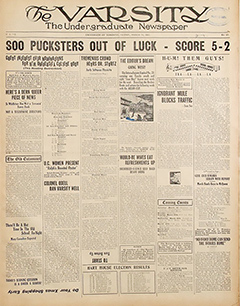
Give students a newspaper, and they will sometimes publish silliness. The Varsity has often been a vehicle for fun, from jokes about lab mice in the second-ever issue in 1880 to upside-down headlines in the ’20s and a hoax in the ’50s about final exams being postponed by two weeks.
The tradition continues to this day with the annual April publication of the Farcity, says editor Alec Wilson, though not everyone always gets the joke. “We have intentionally avoided posting the satirical back pages to the online archive in recent years,” he says, “to avoid having them confused with actual news.”
Happy Campers
Everyone remembers the tents. They sprang up on the fields of U of T Mississauga (then Erindale College) every September throughout the 1970s and ’80s. Was UTM stashing students in truly temporary housing? Nope. It was just the start of orientation.
“In those days, a very large percentage of the students were commuters,” says Arthur Birkenbergs, who was in first year in 1972, eventually graduating with a BA in 1982. He remembers students bringing and pitching about 30 tents on the field where the McLuhan Court residences now stand. “Many students stayed overnight for the three nights of orientation, and there was pub night. There were outings downtown. There was a real kind of a family feel.”
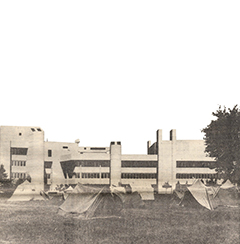
“It was a lot of fun,” says Frank MacGrath (BA 1986 UTM). “There would be all sorts of tents there, from little pup tents to fairly elaborate tents. The whole point was to get the frosh to meet fellow students, and get to know the campus. They’d be doing scavenger hunts, for example – they’d have to find a certain classroom or find a prof.”
At the end of orientation, senior students would gather the assembled campers for a group photo – then sneak up to the roof of a nearby building and rain down water balloons or even Jell-O when the photographer asked them to “Say cheese!”
As UTM grew, the “tent city” became unwieldy. It’s no longer a part of orientation – a lost tradition now, as ephemeral as the tents themselves.
Vic Walks
Most new U of T graduates gather in University College to be sorted and gowned before crossing Front Campus to Convocation Hall. Not Victoria College students. They make their own way from Old Vic on Charles Street, across Queen’s Park, led by their own bagpiper. Police stop traffic for them. How did this unique tradition come to be?
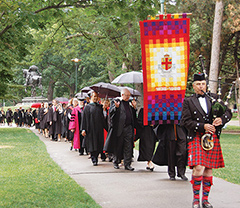
It all started in 1986, says Vic registrar Susan McDonald, when U of T had just started to group graduands by college instead of by program. Alexandra Johnson, who was Victoria’s principal at the time, wanted to create a memorable day for her college. She inaugurated a new schedule: a Vic awards ceremony, lunch in the quad, then the 15-minute, 800-metre procession across Queen’s Park. “We have now been doing this for 29 years, and we have never been late to Con Hall!” says McDonald.
Bagpiper Rory Gus Sinclair has been leading the group for more than 20 years. Behind him floats a colourful gonfalon that was created in 1986 to celebrate Vic’s sesquicentennial. Vic officials in gala academic dress come next, then the stars of the show – the students themselves.
On with the Show
Maybe one of the most anticipated traditions across the university is the annual “show” – from the relatively new Bangladeshi Students’ Association’s Annual Cultural Show to the antics of the 130-year-old UC Follies, the troupe that launched Lorne Michaels of Saturday Night Live fame.
Dentantics burst on the scene in 1921 to an appreciative crowd of 1,500 in Convocation Hall, and a rapturous review in the Varsity, which called the show “a scream” with “up-to-the-minute original jokes.” They even praised “the admirable way the scenery was shifted.” In recent years, the show doubles as a fundraiser for the Faculty of Dentistry’s Access to Care Fund, which subsidizes dental care for patients in the faculty’s clinics.
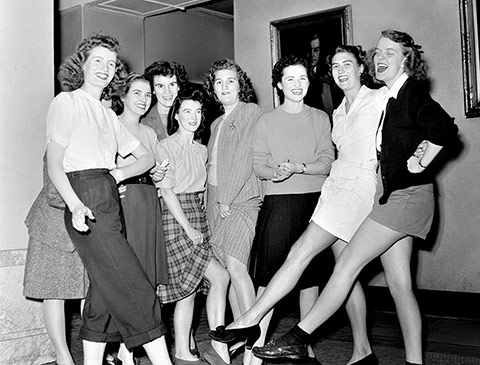
Also in 1921, engineering’s Stunt Night Committee put together an 11-skit show called “Ngynyrs in SPaSms.” That was the first Skule Nite – now a beloved annual four-night extravaganza of musico-theatrical mayhem, and the longest-running show at Hart House Theatre.
February’s Law Follies show lets U of T’s hard-working student lawyers cut loose at least one night of the year. In that spirit perhaps, no one knows when the self-deprecating sketch comedy satire was first performed – but never mind. “It teases law students, it teases professors, it makes fun of the profession,” says second-year law student Rona Ghanbari, this year’s director. “It makes fun of thinking that being a lawyer is so high and mighty.”
Medicine’s Daffydil Night. which launched in 1897, had an on-again-off-again run until 1945; to this day it has raised more than $600,000 for the Canadian Cancer Society. Not that the evening is earnest. David Sowby (MD 1951) shared this memory with the university in 2002: “I came within an ace of being expelled. In my year’s skit I was assigned the role of dean of the Medical School. Part of the trouble was that Dr. Macfarlane was depicted as a hospital orderly, constantly sweeping the floor, saying nothing except ‘Yes, sir’ and ‘No, sir.’” The irate dean wanted heads to roll; fortunately, he was talked down from the brink.
A Triumph of Engineering
To the engineers of a century ago, even the simplest objects held untold possibility. Take the humble chamberpot. Sturdy, smooth-bottomed, with two convenient handles. Thread a cord through those handles, seat one imperious rider on the throne, and have two hapless freshmen haul pot and rider up and down the hallowed corridors of the School of Practical Science. Add a second pot, and you had yourself a chariot race. It was a hugely popular sport.
Time passed, engineers invented indoor plumbing and chariot races became extinct. Or did they? It was Monday, Feb. 2, 1948, and a short notice appeared in the Varsity: “Skule Throws Gauntlet.” It was a challenge to enter a chariot race that Wednesday, on front campus. Entries were not required to look like bathroom fittings.
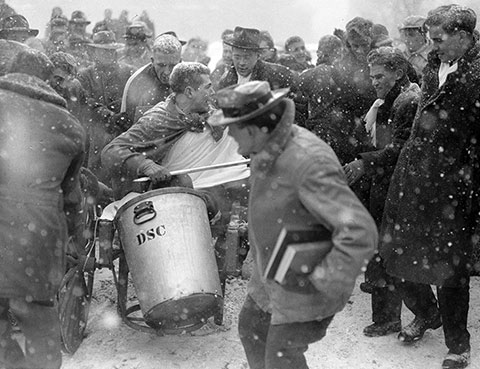
By the next day, the gloves were off. “Inform those spiritless peasants that Vic welcomes the opportunity of defeating Skule in anything, any time, any place!” wrote Keith Davey, the Victoria spokesman. That was mild compared with the rhetoric in Wednesday’s paper, with 11 teams competing for newsprint inches to egg on the other challengers. Oddly, the Varsity’s own team was ranked best bet by impartial handicappers; “Don’t waste your money” being the verdict on the rest.
And who won?
Skule, according to the engineers. But “they are the only ones on the campus who agree with the decision.”
Despite the confusion – or because of it – the raucous race instantly became a popular tradition. Ever since 1953, it’s been open to engineering students alone, in a vain attempt to contain the chaos. Watch them on Front Campus in January. And yes, the trophy is a steel chamberpot.
Read: The 1948 front-campus chariot race – “four wounded, one missing in action”
Fall Colours

Every fall, it’s game on as U of T’s Varsity Blues men’s football team meets the York Lions in the Red and Blue Bowl. The long-standing tussle has taken place since 1970, but didn’t get an official name until the 1980s, when York alum Angelo Kioussis was working as event promotions manager for the Blues. “I’ll never forget those years,” he says, of the time when it was his job to stoke the rivalry.
“I just loved having people enjoy the festivities and the competition,” Kioussis adds, remembering 10,000 students packing Varsity Stadium, 3,000 of them bussed down from York. While a few colourful names were tried out – Kioussis remembers the “Bud Grudge,” after the sponsors, or “Football Mania ’86” – the Red and Blue Bowl was the one that stuck.
In 1992, Nick Volpe, who had been named most valuable player in the 1950 Grey Cup, persuaded the Toronto Argos to donate a trophy. The Blues are 29–17, and hoisted last year’s cup with a 40–3 victory.
Cuppa Custom

The University College Union’s living room at 79 St. George St. looks a bit like Victorian china – all robin’s egg blue walls and moulded, arched white ceiling – so maybe it’s not a surprise that one of U of T’s most gentle and genteel traditions takes place here: Tea and Cookies. Offered to UC students every Monday through Thursday afternoon during the school term for at least 30 years, the sipping is spiced with stimulating conversation. But rules are rules – two cookies per person!
They Begin by Listening
Dr. David McKnight’s students tell him he mustn’t change how he begins his speech to the incoming medical class. So ever since 2010, he’s started it the same way: “Who has ever seen an episode of House? Grey’s Anatomy? Scrubs?
“I have sad news,” McKnight goes on. “This is real life and this is a real medical school. Brilliance does not excuse any behaviour. Boundaries exist, and sex is not the primary motivator. There are professional expectations.”
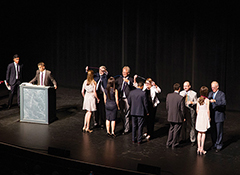
While some universities inaugurate new medical students with a “white coat ceremony,” U of T’s Faculty of Medicine instead holds a stethoscope ceremony. Students, proud as punch, invite their families. McKnight, who is a past associate dean, gives a short talk on professional behaviour, then McKnight and four other faculty members welcome the new students by draping stethoscopes around their necks.
The goal is getting students started on the right foot for an ethical, compassionate professionalism, says McKnight. He ends each speech with a few words about the symbol of the stethoscope. “It is only functional if there is a person at each end,” he says. “And it is all about listening.”
Hall’s Well
From September to April, the Rez Cup – a friendly competition-cum-social event – brightens the lives of students in residence at U of T Scarborough. Students help organize the events, says Jordan Mak, an undergrad who is this year’s residence engagement co-ordinator for UTSC. Favourite events – participation points count! – include September’s Cheer-Off, October’s Haunted Halls decorating competition, a January dodgeball tournament and an April carnival.
“It’s a reason for hallmates to come out who might not have similar personalities,” says Mak, “so we end up having a mingling of various types of students. So far, it’s been working very well.”
Bang!
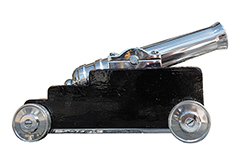
It’s unexpected. It’s loud! And in January 2004, five fire trucks showed up after it accidentally set off fire alarms at Sandford Fleming. Ye Olde Mighty Skule Cannon, as the engineers like to call it, has been shaking things up on campus since the 1920s.
Mighty, that is, in sound, not size – the cannon is usually less than a foot long. But its bang has also been measured at 113 decibels, louder than a power saw.
Some early cannons were stolen (for example, from the Royal Canadian Military Institute); others were little more than homemade explosives in a steel pipe. In the interests of safety, in 1936, university machinist W.H. Kubbinga created a real, if tiny (it was 10 inches long) firearm.
Stealing the cannon was an irresistible challenge to other faculties – and ownership changed hands many times over the years, including 1967, when the fearsome weapon was actually heisted to England before being stolen back. Hence, the cannon’s now-secret location and the now-traditional black-helmeted guard, chained to their beloved blunderbuss at all official firings.
Enthusiastic use at campus events from Orientation to engineering’s Godiva Week means the lifespan of cannons is short, and new ones have been machined every decade or so. But the 2013 version has many bangs left.
Watch: A blast of the Ye Olde Mighty Skule Cannon
JOIN IN!
What U of T traditions do you remember from your time at the university? Share with us at uoft.magazine@utoronto.ca.


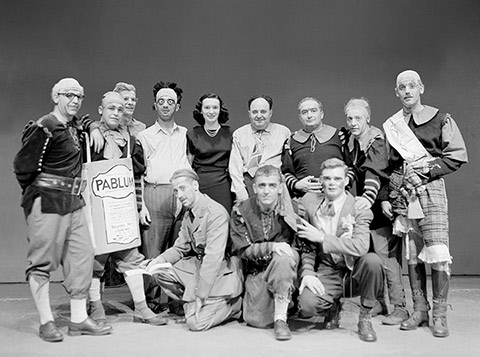



No Responses to “ Those Things We Do ”
The Victoria College tradition of walking across Queen’s Park to Convocation Hall is said to have begun in 1986. I remember a Convocation in the early 60s when we were waiting the arrival of a procession from Vic.
The great Healey Willan was at the organ playing a suitable prelude when the distant sound of bagpipes could be heard. As the volume increased, so did the volume of the organ in a contest of pipes that threatened to raise the roof. On that occasion the pipes were being played by a classmate of mine, David Newman. So, I believe, the tradition is older than the article suggested.
Allan McIntosh
BA 1962 Vic, BD 1965, DMin 1985
Westmount, Nova Scotia